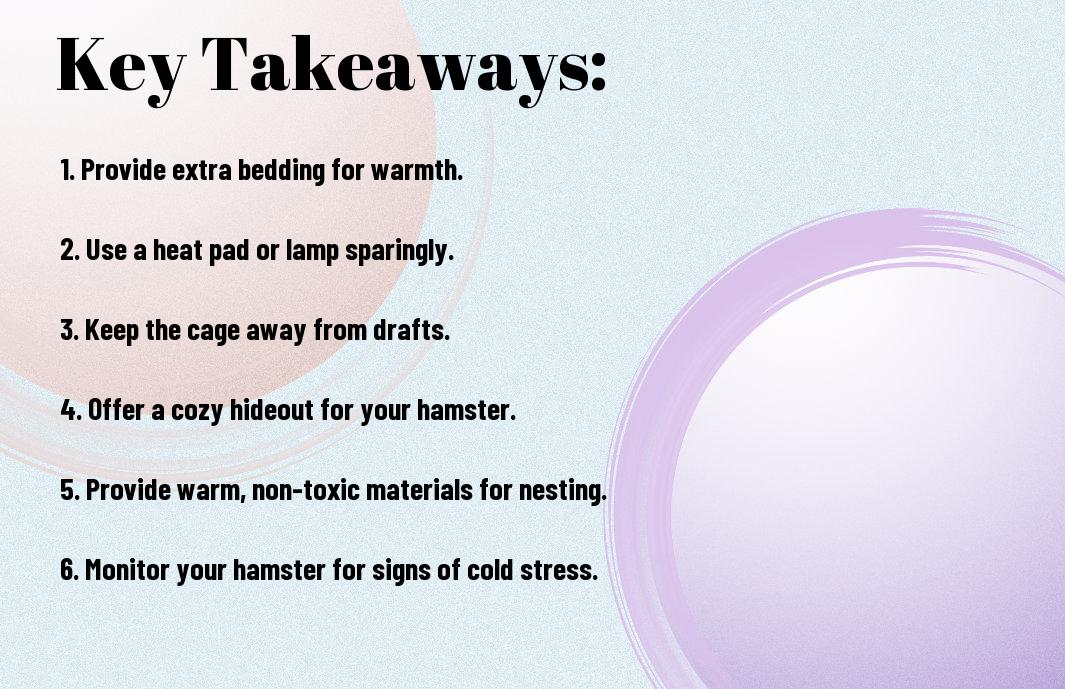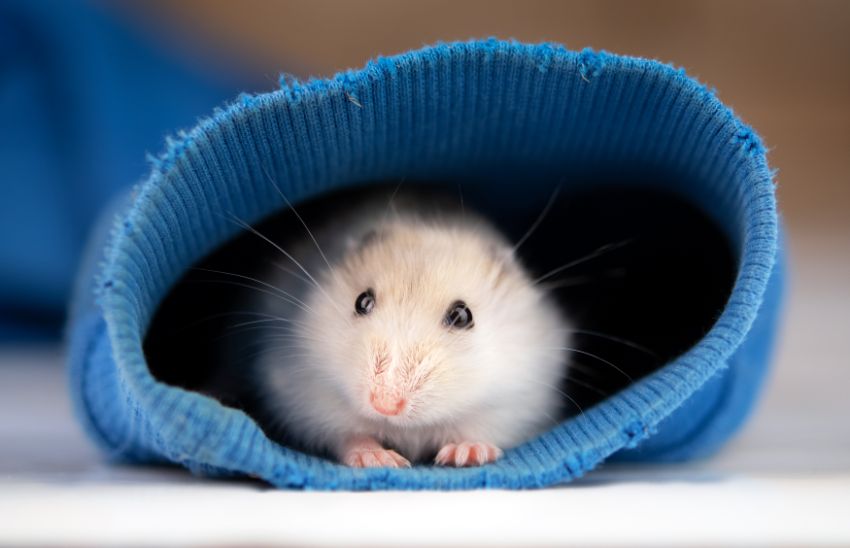Enveloping your precious hamster in a warm and cozy environment is essential to their well-being, particularly during chilly weather. Without adequate warmth and insulation, your hamster can be at risk for illness or even death. It’s important to take proactive measures to ensure your furry friend stays comfortable and safe in their habitat. In this blog post, we’ll explore tips and tricks to help you create a snug and cozy environment for your hamster during the colder months.
Key Takeaways:
- Provide proper bedding: Choose a warm and cozy bedding material such as paper-based bedding or aspen shavings to help keep your hamster insulated and comfortable during chilly weather.
- Ensure a warm environment: Use a heating pad designed for small animals or a ceramic heat emitter to maintain a consistent and comfortable temperature in your hamster’s habitat.
- Offer cozy hideouts: Place cozy hideouts, such as tunnels, igloos, or small houses, in your hamster’s enclosure to provide a sense of security and warmth during cold weather.

Assessing Your Hamster’s Habitat
Obviously, creating a warm and cozy environment for your hamster during chilly weather starts with properly assessing their habitat. This includes evaluating the cage location and draft exposure, identifying signs that your hamster is cold, and understanding the importance of bedding and insulation.
Evaluating Cage Location and Draft Exposure
When assessing your hamster’s habitat, it’s crucial to consider the location of their cage and the potential for draft exposure. Make sure the cage is placed in a warm and draft-free area of your home. Avoid placing it near windows, doors, or air vents that could expose your hamster to cold drafts. Draft exposure can quickly lower the temperature inside the cage, putting your hamster at risk of cold stress or hypothermia. Inspect the cage regularly to ensure that it is not exposed to drafts, and consider using a draft excluder or insulating the surrounding area to maintain a warm environment for your furry friend.
Identifying Signs Your Hamster is Cold
Another important aspect of assessing your hamster’s habitat during chilly weather is understanding the signs that indicate your pet is feeling cold. If you notice your hamster huddled in a corner, shivering, or showing signs of lethargy, these could be indicators that they are feeling cold. It’s essential to address these signs immediately to prevent the risk of cold-related health issues. Providing additional bedding, insulation, or even a small heating pad can help your hamster stay warm and comfortable during the colder months.
Optimizing Temperature and Comfort
After making sure your hamster’s cage is well-insulated and located away from drafts, it’s important to focus on maintaining a comfortable temperature inside the cage. Below, you’ll find important information on how to keep your hamster warm and cozy during chilly weather.
| Safe Heating Options for Your Hamster’s Cage | Choosing the Right Bedding and Nesting Materials |
| Electric heating pads and heat lamps can be effective in keeping your hamster warm, but it’s crucial to ensure that they are designed specifically for small animals and are placed outside the cage to avoid any potential hazards. | Opt for cozy bedding materials like aspen shavings, paper-based bedding, or shredded paper. These options provide warmth and comfort for your furry friend while also being safe and non-toxic. |
Safe Heating Options for Your Hamster’s Cage
When it comes to keeping your hamster warm during chilly weather, it’s essential to choose safe heating options for their cage. Electric heating pads and heat lamps can provide the necessary warmth, but it’s crucial to ensure that these devices are specifically designed for small animals. Additionally, always place the heating source outside the cage to prevent any potential dangers to your pet.
Choosing the Right Bedding and Nesting Materials
The right bedding and nesting materials play a crucial role in keeping your hamster warm and cozy. Opt for bedding options such as aspen shavings, paper-based bedding, or shredded paper, as they provide both warmth and comfort. It’s important to choose non-toxic materials that are safe for your hamster to snuggle in, ensuring their well-being during colder temperatures.
Diet and Activity Considerations
Your hamster’s diet and activity levels are important factors to consider when creating a warm and cozy environment for them during chilly weather.
Nutritional Needs During Colder Months
During the colder months, it’s important to pay attention to your hamster’s nutritional needs. Hamsters are more likely to gain weight in the winter, so it’s important to monitor their food intake and ensure they are getting a balanced diet. Provide a variety of fresh fruits and vegetables, along with high-quality hamster food to keep them healthy and avoid excessive weight gain. Additionally, make sure your hamster has access to fresh, clean water at all times, as staying hydrated is crucial for their overall health.
Exercise and Stimulation to Maintain Warmth
In order to maintain warmth and prevent weight gain during the colder months, it’s essential to keep your hamster active and stimulated. Provide opportunities for exercise by equipping their habitat with running wheels and tunnels. Rotate and introduce new toys to keep them entertained and active. Encouraging regular activity will also help to prevent obesity and promote positive mental health for your hamster. Additionally, consider setting up a warm, comfortable play area outside of their habitat to give them some extra space to explore and exercise. Regular interaction and playtime with your hamster will also help to keep them mentally and physically engaged during the chilly weather.
By paying attention to your hamster’s nutritional needs and providing ample opportunities for exercise and stimulation, you can help them stay warm, healthy, and happy during the chilly weather.
Monitoring Your Hamster’s Health
Now that you’ve created a warm and cozy environment for your hamster during chilly weather, it’s important to monitor your furry friend’s health to ensure they stay happy and active. Regular check-ups and close observation of your hamster’s behavior can help you catch any potential health issues early on and provide the necessary care.
Recognizing Behavior Changes and Health Issues
Pay close attention to your hamster’s behavior and daily activities. Any sudden changes such as decreased activity, loss of appetite, or unusual aggression can be signs of health issues. Keep an eye on your hamster’s fur and body condition, and immediately consult a veterinarian if you notice any **unexplained weight loss, hair loss, or abnormal bumps or lumps**. Respiratory problems such as **sneezing, wheezing, or labored breathing** can also indicate health issues and should be promptly addressed.
Regular Check-ups and Preventive Care
Schedule regular check-ups with a veterinarian who is experienced in small exotic pets such as hamsters. **Regular dental care, parasite prevention, and vaccinations** are essential for maintaining your hamster’s overall health and well-being. During the check-up, the veterinarian will also conduct a thorough physical examination to identify any potential health concerns. Additionally, **maintain a clean and hygienic living environment for your hamster** to prevent common health issues such as **bacterial infections and skin irritations**.
Creating a Warm and Cozy Environment for Your Hamster During Chilly Weather
With this in mind, it is essential to provide your hamster with the necessary warmth and comfort during colder months. By employing techniques such as adding extra bedding, using a heating pad, and ensuring their cage is situated in a draft-free area, you can ensure your hamster remains cozy and content. Making these adjustments will not only keep your hamster comfortable, but also promote their overall well-being and happiness during the chilly weather.
FAQ
Q: What measures can I take to create a warm and cozy environment for my hamster during chilly weather?
A: To create a warm and cozy environment for your hamster during chilly weather, you can place the cage in a warm area of your home, away from drafts and cold spots. Additionally, you can provide extra bedding for your hamster to burrow in and consider using a heating pad designed specifically for small animals. It’s important to monitor the temperature in the cage to ensure it stays within a comfortable range for your hamster.
Q: How can I ensure my hamster stays warm without overheating during chilly weather?
A: To ensure your hamster stays warm without overheating, it’s important to carefully monitor the temperature in the cage. Avoid using heating pads designed for humans, as they can be too hot for small animals. Instead, opt for a small animal-safe heating pad and place it under a portion of the cage so your hamster can choose whether to be near the warmth or not. Additionally, providing ample bedding for burrowing will allow your hamster to regulate its own body temperature.
Q: Are there any specific types of bedding or materials that are best for creating a warm and cozy environment for my hamster during chilly weather?
A: When creating a warm and cozy environment for your hamster during chilly weather, it’s best to use safe and comfortable bedding materials such as aspen shavings, paper-based bedding, or hemp bedding. Avoid using cedar or pine shavings, as the aromatic oils can be harmful to small animals. Additionally, provide extra nesting materials such as shredded paper or dried grasses to allow your hamster to create a warm and cozy nest.














